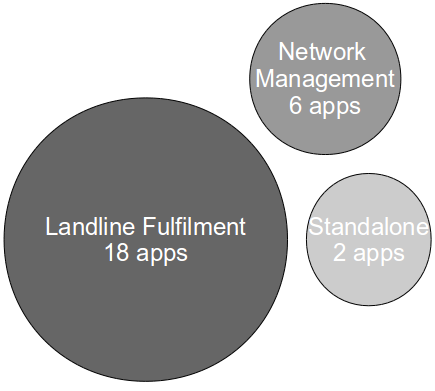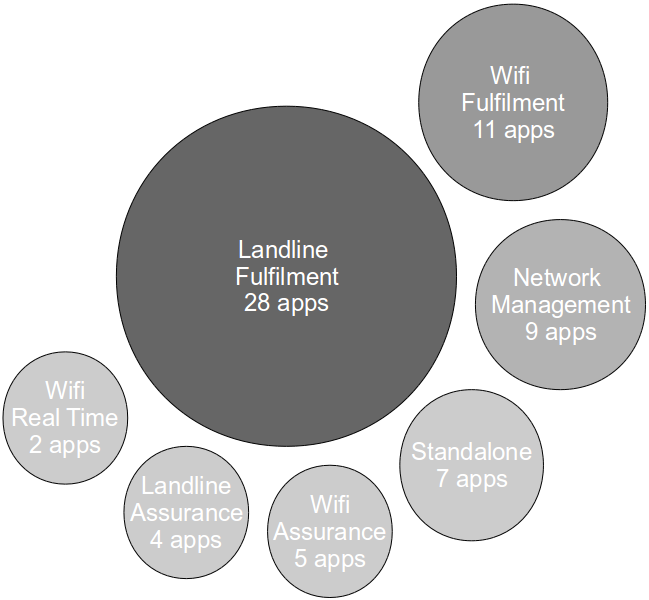The Strangler Pipeline scales via a Artifact Container and Aggregate Artifacts
Previous entries in the Strangler Pipeline series:
While Continuous Delivery experience reports abound from organisations such as LMAX and Springer, the pipelines described tend to be focussed upon applying the Repeatable, Reliable Process and Automate Everything principles to the release of a single application. Our Continuous Delivery journey at Sky Network Services has been a contrasting experience, as our sprawling application estate has led to significant scalability demands in addition to more common challenges such as slow build times and unrepeatable release mechanisms.
When pipeline development began 18 months ago, the Sky Network Services application estate consisted of our Network Inventory and Landline Fulfilment platforms of ~25 applications, with a well-established cycle time of monthly Production releases.
However, in a short period of time the demand for pipeline scalability skyrocketed due to the introduction of Fibre Broadband, Landline Assurance, Wifi Fulfilment, Wifi Realtime, and Wifi Assurance:
This means that in under a year our application estate doubled in size to 6 platforms of ~65 applications with the following characteristics:
- Different application technologies – applications are Scala or Java built by Ant/Maven/Ruby, with Spring/Yadic application containers and Tomcat/Jetty/Java web containers
- Different platform owners – the Landline Fulfilment platform is owned by multiple teams
- Different platforms for same applications – the Orders and Services applications are used by both Landline Fulfilment and Wifi Fulfilment
- Different application lifecycles – applications may be updated every day, once a week, or less frequently
To attain our scalability goals without sacrificing cycle time we followed the advice of Jez Humble and Dave Farley that “the simplest approach, and one that scales up to a surprising degree, is to have a [single] pipeline“, and we built a single pipeline based upon the Artifact Container and Aggregate Artifact pipeline patterns.
For the commit stage of application artifacts, the pipeline provides an interface rather than an implementation. While a single application pipeline would be solely responsible for the assembly and unit testing of application artifacts, this strategy would not scale for multi-application pipelines. Rather than incur significant costs in imposing a common build process upon all applications, the commit interface asks that each application artifact be fully acceptance-tested, provide associated pipeline metadata, and conform to our Artifact Container. This ensures that application artifacts are readily accessible to the pipeline with minimal integration costs, and that the pipeline itself remains independent of different application technologies.
For the creation of platform artifacts, the pipeline contains a commit stage implementation that creates and persists aggregate artifacts to the artifact repository. Whereas an application commit is automatically triggered by a version control modification, a platform commit is manually triggered by a platform owner specifying the platform version and a list of pre-built constituent application artifacts. The pipeline compares constituent metadata against its aggregate definitions to ensure a valid aggregate can be built, before creating an aggregate XML file to act as a version manifest for future releases of that platform version. The use of aggregate artifacts provides a tool for different teams to collaborate on the same platform, different platforms to share the same application artifacts, and for different application lifecycles to be encapsulated behind a communicable platform release version.
While the Strangler Pipeline manages the release of application artifacts via a Repeatable Reliable Process akin to a single application pipeline, the use of the Aggregate Artifact pattern means that an incremental release mechanism is readily available for platform artifacts. When the release of an aggregate artifact into an environment is triggered, the pipeline inspects the metadata of each aggregate constituent and only releases the application artifacts that have not previously entered the target environment. For example, if Wifi Fulfilment 1.0 was previously released containing Orders 317 and Services 192, a release of Wifi Fulfilment 2.0 containing Orders 317 and Services 202 would only release the updated Services artifact. This approach reduces lead times and by minimising change sets reduces the risk of release failure.
A good heuristic for pipeline scalability is that a state of Authority without Responsibility is a smell. For example, we initially implemented a per-application configuration whitelist as a hardcoded regex within the pipeline. That might have sufficed in a single application pipeline, but the maintenance cost in a multi-application pipeline became a painful burden as different application-specific configuration policies evolved. The problem was solved by making the whitelist itself configurable, which empowered teams to be responsible for their own configuration and allowed configuration to change independent of a pipeline version.
In hindsight, while the widespread adoption of our Artifact Container has protected the pipeline from application-specific behaviours impeding pipeline scalability, it is the use of the Aggregate Artifact pattern that has so successfully enabled scalable application platform releases. The Strangler Pipeline has the ability to release application platform versions containing a single updated application, multiple updated applications, or even other application platforms themselves.

